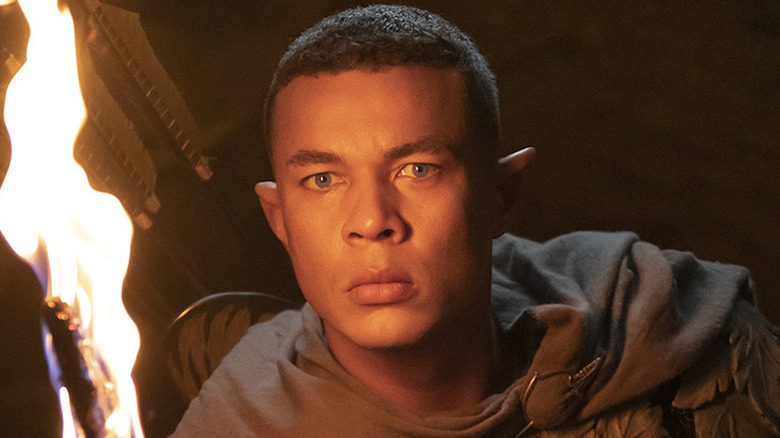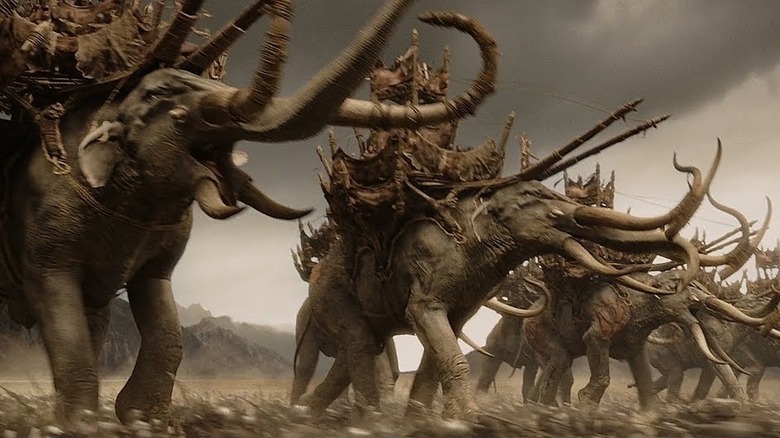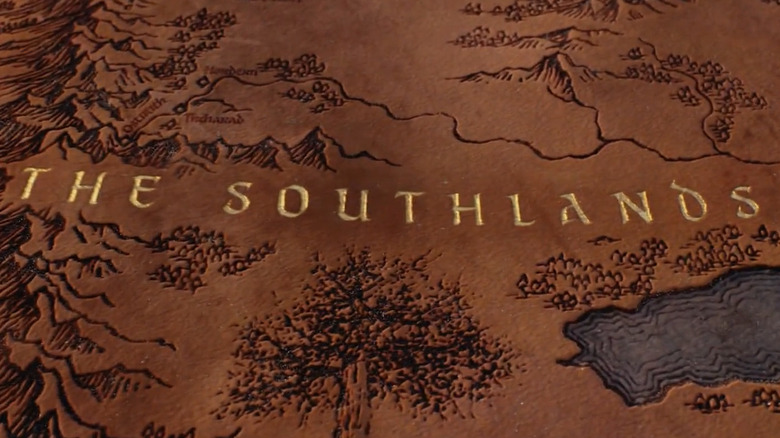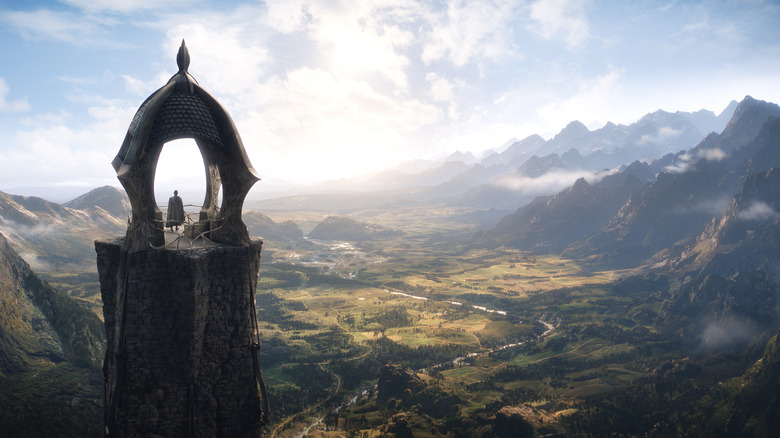We've Seen The Rings Of Power's Southlands Before, And That's Very Bad News For The People There
"The Lord of the Rings: The Rings of Power" has introduced a massive cast of characters who live across more than half a dozen different areas on the Middle-earth map. Some of these character-location combos are lifted straight from the source material. For instance, Tolkien has Elrond and Gil-galad in Lindon during this era. Celebrimbor leads Eregion in the author's books, and Durin III and Durin IV are accurately seen as Khazad-dûm royalty.
And then there are the characters who have been made up for the show. For instance, the Harfoots come from a proto-Hobbit race wandering in eastern Middle-earth when the show starts. Both the presence and location of the Halfling community aren't closely following Tolkienian lore, which gives their story a unique and mysterious element.
Another area that is filled with new faces and storylines is the Southlands. Tolkien didn't write much about the lower regions of Middle-earth at all, especially during the Second Age, when this story is set. This has given the "Rings of Power" creators some adaptive leeway with this part of the story, and it's an opportunity that they've taken advantage of, especially regarding the geographic region itself.
The Lord of the Rings fans know the Southlands
Whether they know it or not, the Southlands aren't new to anyone familiar with "The Lord of the Rings." The area, which Tolkien describes as right below Mordor, includes the key kingdoms of Harad and Khand, which the Dark Lord uses to recruit soldiers for his armies.
Gollum describes these areas in "The Two Towers" novel, discussing a vast southern region of the content where the Yellow Face is very hot, and there are vast bodies of water with lots of fish. Later, the text explains that Gandalf is known as Incánus "in the South." At the Council of Elrond, in "The Fellowship of the Ring" book, Aragorn also describes his difficult life by saying, "I have crossed many mountains and many rivers, and trodden many plains, even into the far countries of Rhûn and Harad where the stars are strange."
The Southlands are certainly present throughout the "Lord of the Rings" story, even if they're always on the edge of the narrative. In the Second Age, when "The Rings of Power" is set, we still hear little bits about the Southern regions, although the info is focused, more than anything else, on the coastlands and their interactions with the island nation of Númenor. But showrunners J.D. Payne and Patrick McKay seem set on exploring this vast meridional region in more detail for Prime Video's Middle-earth series.
Exploring the Southlands in Rings of Power
When "The Rings of Power" started amping up its promotional campaign earlier in the year, it began highlighting a handful of the show's characters who hail from the Southlands. Bronwyn is a village healer whose son, Theo, finds a sinister broken sword blade. Arondir is a Silvan Elf patrolling the region to make sure the local Men — whose ancestors fought for the original Dark Lord Morgoth long before — don't get too arrogant.
After many smaller details, the show released a featurette on the Southlands just a couple of weeks before it went live on Prime Video. There are lots of little tidbits of info worth knowing in the clip, but the shot that caused the most buzz took place in the first five seconds. During that time, the camera pans across the Middle-earth map to reveal the Southlands. The interesting part? The words "The Southlands" on the map are planted right across the area that will eventually be known as Mordor. Chyeah.
Just below and to the right of the words is the distinct shape of Lake Núrnen, which is located in the bottom left-hand corner of future-Mordor. In "The Return of the King" novel, it explains this area when it says that "Neither [Sam] nor Frodo knew anything of the great slave-worked fields away south in this wide realm, beyond the fumes of the Mountain by the dark sad waters of Lake Núrnen." In other words, this area is located just below the black and destroyed area of Mordor that we're all used to and is closer to the "slave-worked fields" in southern Mordor that help feed Sauron's armies later on. While interesting to note, none of this changes the fact that this area is right in future-Mordor proper.
What Rings of Power's Southlands means for the story
"The Rings of Power" creators are clearly nudging the vague geographical line considered "the Southlands" significantly higher in their story. The question is, what does that mean for the narrative itself? After all, when we see people in the Southlands in the show, the area isn't blackened. Nor is it slave-worked. We see the region before Sauron perverts it to his villainous needs.
This means we're probably going to see the area transform from a peaceful, rural countryside worked by local inhabitants into the dictatorial region of Mordor — and there are a couple of things that could be the defining event to kick off that transformation, starting with Orodruin — aka, Mount Doom.
The book "The Peoples of Middle-earth" talks about the "volcano Orodruin and its eruptions — which were not made by Sauron but were a relic of the devastating works of Melkor in the long First Age." This indicates that Mount Doom had volcanic potential long before "The Rings of Power." "The Silmarillion" adds that "there was a fiery mountain in that land that the Elves named Orodruin. Indeed for that reason Sauron had set there his dwelling long before, for he used the fire that welled there from the heart of the earth in his sorceries and in his forging." Finally, "The Return of the King" states that 1,000 years into the Second Age, "Sauron, alarmed by the growing power of the Númenóreans, chooses Mordor as a land to make into a stronghold. He begins the building of Barad-dûr." Between Sauron's shiny new stronghold and the fiery mountain, the Southlands will likely see their homeland transforming into Mordor at some point along the way. Whatever the cause, it's bad news for the inhabitants of that region.



